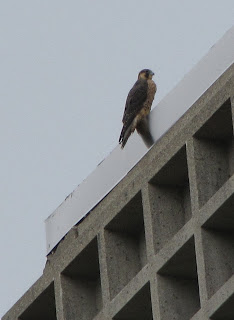My friend Jeff Boettner tells the story of how he and his wife Cynthia were visiting Whitefish Point, Michigan during the hawk and owl migration when they met a woman coming back from the dunes. They asked the lady if she had seen anything exciting. She said that others claimed to have seen “a pair of green falcons," but all she saw was one bird.
I don’t have to go all the way to Michigan to see peregrine falcons. There is a resident pair right on the University of Massachusetts campus here in Amherst. They tend to hang out around the Campus Center, which has a high-rise hotel in the middle of it. One morning I spotted one of the birds perched on a light jutting out from the building. I ran back to my lab to get my camera, then spent the next half hour chasing the bird and its mate around the building. All I managed were a few shots from roughly 200 vertical feet away in bad light, including my specialty, “silhouette of bird leaving.” 

Ok, I got a few shots and a backache.
As natural nesting sites have dwindled due to development and habitat fragmentation, it occurred to wildlife officials to try introducing falcons to the next best thing to a cliff: a skyscraper. “Hacking” is the term used to describe the process of releasing young falcons raised in captivity from a cage-like shelter placed atop a building. This has worked so well that falcons across the country are now returning on their own to nest in their birthplace cities, using buildings and bridges as sites for nesting.
The pair here on campus has chosen to nest atop the W.E.B. DuBois Library, a building that must be the tallest structure in the state west of Boston. You can’t see the top of it on a foggy morning. The Campus Pond below the library provides plenty of waterfowl for these “duck hawks” to feed on, though they are more apt to go after slightly smaller game like pigeons. There are remarkably few pigeons here, actually, and now I know why. I wonder if the Massachusetts Division of Fisheries and Wildlife would consider loaning some falcons to Tucson?
Should the falcons successfully launch their offspring (and I’m pretty sure I saw a fledgling this past Wednesday), it would mark the twentieth bird to have been reared here.
Meanwhile, on the evening of Tuesday, July 14, I saw the adult falcons over my neighborhood in South Deerfield. I even have a grainy image to prove it:  Well, I thought it was the pair from the university. It turns out that there is another male and female nesting on Mount Sugarloaf just down the street. So, I can’t be sure just which birds I was looking at after all. Hey, after decades of declining raptor populations from the effects of DDT, it is a pleasant quandary to have two pairs of peregrines to tell apart.
Well, I thought it was the pair from the university. It turns out that there is another male and female nesting on Mount Sugarloaf just down the street. So, I can’t be sure just which birds I was looking at after all. Hey, after decades of declining raptor populations from the effects of DDT, it is a pleasant quandary to have two pairs of peregrines to tell apart.
For more about the UMass couple, see this online article. Watch this space for more falcon memories from yours truly.
No comments:
Post a Comment